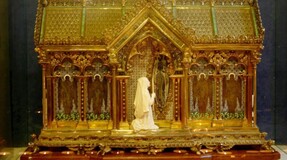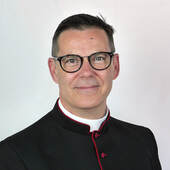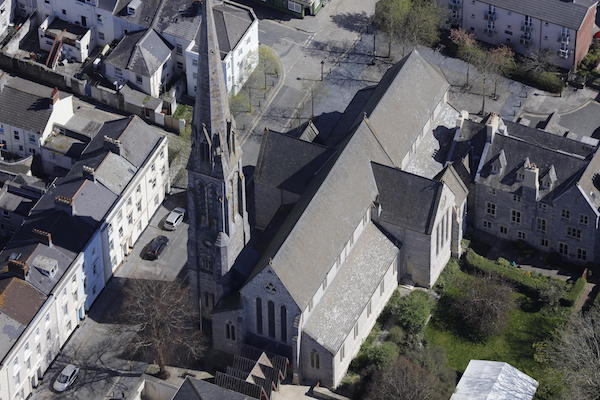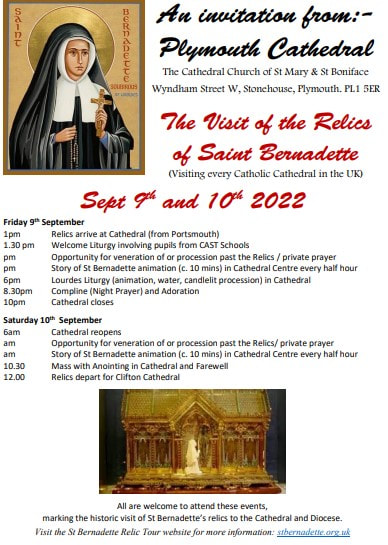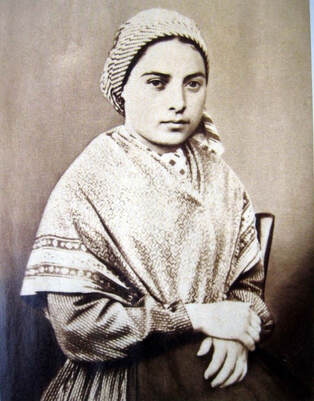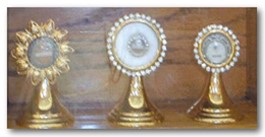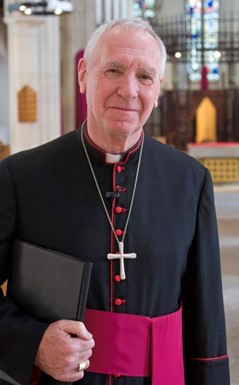Relics of St Bernadette of Lourdes
After much anticipation the day finally arrived when we were able to receive the Relic of St Bernadette to Plymouth Cathedral.
The rain stopped and the sun shone throughout her visit as the many pilgrims came to visit and attend the various liturgies celebrated in her honour. here are a few of the photographs taken on what was a truly an inspiring occaision.
The rain stopped and the sun shone throughout her visit as the many pilgrims came to visit and attend the various liturgies celebrated in her honour. here are a few of the photographs taken on what was a truly an inspiring occaision.
The Story of Bernadette
|
Vatican News becomes the latest media outlet to cover the historic visit of the Relics of St Bernadette, follow the link to go to Vatican News to read the article and listen to the latest iterview given by Canon Mark O'Keeffe.
|
BBC Radio Devon -
21/08/2022, Canon Mark - Cathedral Dean, speaks to Angela Kalwaites (BBC Radio Devon) on the forthcoming visit of the Relics of St Bernadette
A SAINT’S VISIT
Press release issued 10th August
The Tablet - The International Catholic News Weekly
This week The Tablet posted an interesting aricle by the Dean of the Cathedral - Canon Mark O'Keeffe - explaining the Once in a lifetime opportunity of the visit of St Bernadette's relics to Plymouth.
|
Plymouth's Catholic cathedral will host the relics on 9-10 September this year as they tour the UK.
When something is billed as “once in a lifetime” it makes people stop and look. The 9-10 September is a red-letter day for us here in the south-west of England, when the relics of St Bernadette will come to the cathedral at Plymouth during their visit to the UK. We have been busily arranging a programme of events and liturgies which will reflect the unique occasion. The relics of one of the world’s most famous saints, the girl chosen as the mouthpiece of Our Lady to herald the Immaculate Conception and the cure of the sick, has special resonance for us. Our Cathedral Church of St Mary and St Boniface opened its doors on the 25 March 1858, the very same day that Our Lady appeared to St Bernadette and said: “I am the Immaculate Conception.” Within the diocese there is also another connection to Lourdes – the church of Our Lady of Victories and St Bernadette located in Ensbury Park, Bournemouth, is the first church in England to be dedicated to her patronage.Over the years, tens of thousands of people from our diocese have made the pilgrimage to Lourdes, looking for healing, solace, peace, and faith. The pilgrimage to this most |
visited Christian site is a blessing for those who have been able to make the journey. On my many visits to Lourdes, my experience has been such that the pilgrims I have journeyed with – able and disabled alike – have unknowingly led me into a deeper relationship of faith
I have listened to many pilgrim volunteers say that they have received far more from the sick pilgrims that they have accompanied than they have given as volunteers during the time they have spent together. The Lourdes experience is a microcosm of the Church, where the suffering bring healing to those who are physically well. At the heart of the Lourdes story is the saint to whom we owe so much and will venerate when she comes to visit us. I was a seminarian when I first went to Lourdes with the Handicapped Children’s Pilgrimage Trust. I remember that I was very nervous and that my fear fell away as soon as I stepped on the coach to go to the airport because everyone was so friendly and inclusive. I was a volunteer helper to a young boy who have become paralysed after an accident; his life was a tremendous source of inspiration to me. We both received much from sitting in silence together, and from navigating the wheelchair around the crowds at the Grotto, the baths, the sacrament of the sick ceremony and the torchlight procession. And there was lots of laughter too. Compare that to the time that I took soldiers as their army chaplain. |
The Cathedral Church of St Mary and St Boniface in Plymouth, opened on 25 March 1858 - the same date that Our Lady told St Bernadette “I am the Immaculate Conception”. Commission Air/Alamy
These were men who were healthy and strong, who were unafraid to show their softer side in their care for the sick, the elderly and the lame. Military from across the world enjoyed spending time with Our Lady, reconciling with each other and marching together, and time dedicated to silence and prayer. These pilgrimages to Lourdes have enriched my priestly ministry, and shown me the way to serve.
One venerable priest within our Diocese of Plymouth who is particularly looking forward to the visit of St Bernadette happens to be a canon of Lourdes, made so by the Bishop of Lourdes and Tarbes. He describes the experience of Lourdes in a very simple and calming way: as the coming together of a global family where all are welcome and all are equal whatever their social status in life when they return to their own cities and towns. I hope that this deep sense of calm and simplicity will be the experience of those coming to Plymouth Cathedral in the presence of St Bernadette. Our canon says that Lourdes is such a wonderful place because Our Blessed Lady is there waiting to listen to our petitions. In our own cathedral, the Marian altar is always adorned with |
petitions and flowers placed by people from all over the world who come to Our Lady to be heard and to share their hopes and dreams, joys as well as sorrows.
The words of the saints teach us and help us to grow, none more so than the words of St Bernadette: “I shall spend every moment loving. One who loves does not notice her trials; or perhaps more accurately, she is able to love them.” When it comes to the cathedral, the mother church of the diocese, we are conscious that the people of God have been through so much since the day of the cathedral doors’ first opening – a story of the community of faith overcoming pestilence, war, the blitz and most recently, a pandemic, uncertainty, isolation and fear. We hope to be inspired once again by the life of St Bernadette, who trusted. When asked whether her vision of the Virgin Mary as beautiful she replied: “Oh! Oh! Yes indeed! And even more than that! So lovely that, when you have seen her once, you would willingly die to see her again! St Bernadette met and knew the love, compassion and succour of Jesus Christ. We hope that we will take this experience as a privilege and a part of our story to take to the people of this delightful city by the sea and further afield, for generations to come. Saint Bernadette – pray for us. Canon Mark O'Keefe is the cathedral dean in the Diocese of Plymouth. The relics of St Bernadette will visit the Cathedral of St Mary and St Boniface 9-10 September. Other dates of the relic tour are available at stbernadette.org.uk. With thanks to the The Tablet for permission to share this article on our website. |
Who Was St Bernadette?
|
St Bernadette was born in 1844 to a poor family in Lourdes, in France. She was baptised when she was 2 days old at her parish church in Lourdes. Bernadette was one of 9 children.
Bernadette was 13 years old when she started to learn French, and to read and write. She was the eldest daughter, so she was put in charge of her brothers and sisters while her parents worked. She couldn’t go to school because she had to help her family. One day Bernadette went to collect firewood with her sister and a friend when something happened that completely changed her life and the place where she lived. This was the first of 18 visions, when she described seeing ‘a small young lady’. She said that the beautiful lady had told her to go back, but Bernadette’s Mother didn’t want her to. Bernadette’ described her as the lady, but it was really the Virgin Mary, the mother of God. Bernadette was the only person to see her. The lady told Bernadette to drink from the spring that flowed under the rock. So, she tried digging into the mud, until eventually she found clear drinking water. But the onlookers, just saw mud on her face and didn’t believe her. But in the next few days a spring flowed, and people thought the water had special healing powers. People still visit the spring today in the hope that it will heal and cure them. Bernadette always believed that faith and prayer cured the sick. Bernadette decided that she wanted to devote her life to God. She went to a convent in Nevers. She spent the rest of her life there, helping others and creating beautiful, embroidered garments for church. She died on 16th April at the age of 35. The feast day of St Bernadette is April 16th |
Encountering the Relics of St Bernadette
Encountering the Relics of St Bernadette
In September and October this year, the relics of St Bernadette will journey on pilgrimage to England, Scotland, and Wales for the very first time. This very special once in a lifetime event will provide an opportunity for people of all ages and backgrounds to experience the special gifts and charisms of Lourdes,
The relics of Saint Bernadette will travel from the Upper Basilica in Lourdes to every Catholic Cathedral in the UK arriving in Plymouth on the 9th September.
St Bernadette’s Story
St Bernadette was born in 1844 in a small town in France. Bernadette Soubirous was one of eight children born into a very poor family. Although initially unremarkable, Bernadette’s life was to inspire generations of people to journey in faith on pilgrimage to Lourdes.
Between 11 February and 16 July 1858, Bernadette saw the Virgin Mary eighteen times in a series of Apparitions that took place in cave on the outskirts of Lourdes, a place now known as the Grotto of Massabielle. In the course of these miraculous encounters, Bernadette, then aged just 14, became the friend and confidante of Our Lady, the mother of Jesus.
The Apparitions of Lourdes were authenticated in 1866 by the Bishop of Tarbes. In that same year, Bernadette left Lourdes to live out her religious vocation within the community of the Sisters of Charity of Nevers. She died in 1879, was proclaimed blessed in 1925, and a became a saint in 1933.
Visit the St Bernadette Relic Tour website for more information: stbernadette.org.uk
Venue: Cathedral Church of St Mary and St Boniface: Wyndham Street W, Stonehouse, Plymouth, PL1 5ER
Arrive: 09/09/2022 13:00 Depart: 10/09/2022 12:00
In September and October this year, the relics of St Bernadette will journey on pilgrimage to England, Scotland, and Wales for the very first time. This very special once in a lifetime event will provide an opportunity for people of all ages and backgrounds to experience the special gifts and charisms of Lourdes,
The relics of Saint Bernadette will travel from the Upper Basilica in Lourdes to every Catholic Cathedral in the UK arriving in Plymouth on the 9th September.
St Bernadette’s Story
St Bernadette was born in 1844 in a small town in France. Bernadette Soubirous was one of eight children born into a very poor family. Although initially unremarkable, Bernadette’s life was to inspire generations of people to journey in faith on pilgrimage to Lourdes.
Between 11 February and 16 July 1858, Bernadette saw the Virgin Mary eighteen times in a series of Apparitions that took place in cave on the outskirts of Lourdes, a place now known as the Grotto of Massabielle. In the course of these miraculous encounters, Bernadette, then aged just 14, became the friend and confidante of Our Lady, the mother of Jesus.
The Apparitions of Lourdes were authenticated in 1866 by the Bishop of Tarbes. In that same year, Bernadette left Lourdes to live out her religious vocation within the community of the Sisters of Charity of Nevers. She died in 1879, was proclaimed blessed in 1925, and a became a saint in 1933.
Visit the St Bernadette Relic Tour website for more information: stbernadette.org.uk
Venue: Cathedral Church of St Mary and St Boniface: Wyndham Street W, Stonehouse, Plymouth, PL1 5ER
Arrive: 09/09/2022 13:00 Depart: 10/09/2022 12:00
Church Teaching on Relics
An article by REV. CHARLES MANGAN
Some people think the Catholic Church abandoned her teaching on relics after Vatican II. However, a quick glance at the Code of Canon Law, published by authority of Pope John Paul II in 1983, reveals that the Church very much considers sacred relics to be important and significant in the life of the Church (cf. canons 1281-89). Just what are relics and what meaning do they have for disciples of Jesus Christ?
Some people think the Catholic Church abandoned her teaching on relics after Vatican II. However, a quick glance at the Code of Canon Law, published by authority of Pope John Paul II in 1983, reveals that the Church very much considers sacred relics to be important and significant in the life of the Church (cf. canons 1281-89). Just what are relics and what meaning do they have for disciples of Jesus Christ?
Just what are relics and what meaning do they have for disciples of Jesus Christ?
The word relic comes from the Latin relinquo, literally meaning I leave, or I abandon. A relic is a piece of the body of a saint, an item owned or used by the saint, or an object which has been touched to the tomb of a saint. Traditionally, a piece of the body of a saint, especially that of a martyr, may be with the permission of the local ecclesiastical authority used in solemn processions recalling the specific holy person.
It may seem strange that Christianity, which so adheres to the belief in the resurrected body after the final judgment, should attach veneration to body parts of the faithful departed. But as Dom Bernardo Cignitti, O.S.B., once wrote, In a religion as spiritually centred as Christianity, the remains of certain dead are surrounded with special care and veneration. This is because the mortal remains of the deceased are associated in some manner with the holiness of their souls which await reunion with their bodies in the resurrection.
Venerable history
The veneration of sacred relics has a long history in the Church. It is commonly held that the first account of such veneration stretches back to the martyrdom of St. Polycarp, bishop and martyr, who was killed by being burned at the stake in the amphitheatre at Smyrna around the year 155 A.D. One such reference, which comes from the Office of Readings assigned to the memorial of St. Polycarp (February 23) in the Liturgy of the Hours, states: When the pyre was ready, Polycarp took off all his clothes and loosened his undergarment. He made an effort also to remove his shoes, though he had been unaccustomed to this, for the faithful always vied with each other in their haste to touch his body. Even before his martyrdom he had received every mark of honour in tribute to his holiness of life.
The Fathers of the Church take up the theme of the reverence paid to the sacred relics as early as the fourth and fifth centuries. By the 1100s, relics were being venerated in churches and shrines which attracted numerous pilgrims.
As time went on, the clothing and personal effects of holy men and women and boys and girls of the Lord were also enshrined. Abbot Cignitti observed: This was because of the widespread belief, beyond measure in the centuries of the early Middle Ages, that the wonder-working power of the saint was to be found not only in the entire body but also in every part of it and in objects that had been in contact with his person.
After the death of Emperor Constantine (fourth century), cases of wood, ivory, and various metals containing relics were deposited in altars at the time of their dedication or buried near the tombs of the dead or even worn around the neck. It is well-known that altars at the time of their consecration by the bishop were to have inserted a relic of a saint, preferably a martyr, which was kissed by the priest as he began to offer the Holy Sacrifice of the Mass. It is still earnestly recommended that every altar possess a relic of one of the saints.
First-class doctrine
There are three classes of sacred relics. The first-class is a part of the saints body. (It is this type which is placed in an altar stone.) The second-class is a piece of the saints clothing or something used by the saint, while the third-class is an object which has been touched to a first-class relic.
Isn’t the veneration of relics optional for Catholics? Must the Catholic faithful really esteem the bodies of the saints? Once and for all, the Council of Trent (16th century) responded to the claims of the reformers that both the veneration of the saints and their relics is contrary to Sacred Scripture. The Council taught: Also the holy bodies of the holy martyrs and of the others who dwell with Christ . . . are to be honoured by the faithful.
There are several scriptural passages that support the veneration of relics. For example, the Israelites took Josephs bones when they departed Egypt (Ex. 13:19). The bones of Elisha came in contact with a dead person who then was raised to life (2 Kings 13:21). The same Elisha took the mantle of Elijah and fashioned a miracle with it (2 Kings 2:13). The Christians of Ephesus, by using handkerchiefs and cloths touched to St. Pauls skin, effected the healing of the sick (Acts 19:12).
Communion of saints
To venerate the relics of the saints is a profession of belief in several doctrines of the Catholic faith: (1) the belief in everlasting life for those who have obediently witnessed to Christ and His Holy Gospel here on earth; (2) the truth of the resurrection of the body for all persons on the last day; (3) the doctrine of the splendour of the human body and the respect which all should show toward the bodies of both the living and the deceased; (4) the belief in the special intercessory power which the saints enjoy in heaven because of their intimate relationship with Christ the King; and (5) the truth of our closeness to the saints because of our connection in the communion of saints we as members of the Church militant or pilgrim Church, they as members of the Church triumphant.
The relics of the saints and their veneration is just another in the long line of treasures which Jesus Christ has given to His chaste bride, the Church. These relics summon us to appreciate more profoundly not only the heroic men and women, boys and girls who have served the Master so selflessly and generously, but especially the love and mercy of the Almighty who called these His followers to the bliss of unending life in His eternal kingdom.
The word relic comes from the Latin relinquo, literally meaning I leave, or I abandon. A relic is a piece of the body of a saint, an item owned or used by the saint, or an object which has been touched to the tomb of a saint. Traditionally, a piece of the body of a saint, especially that of a martyr, may be with the permission of the local ecclesiastical authority used in solemn processions recalling the specific holy person.
It may seem strange that Christianity, which so adheres to the belief in the resurrected body after the final judgment, should attach veneration to body parts of the faithful departed. But as Dom Bernardo Cignitti, O.S.B., once wrote, In a religion as spiritually centred as Christianity, the remains of certain dead are surrounded with special care and veneration. This is because the mortal remains of the deceased are associated in some manner with the holiness of their souls which await reunion with their bodies in the resurrection.
Venerable history
The veneration of sacred relics has a long history in the Church. It is commonly held that the first account of such veneration stretches back to the martyrdom of St. Polycarp, bishop and martyr, who was killed by being burned at the stake in the amphitheatre at Smyrna around the year 155 A.D. One such reference, which comes from the Office of Readings assigned to the memorial of St. Polycarp (February 23) in the Liturgy of the Hours, states: When the pyre was ready, Polycarp took off all his clothes and loosened his undergarment. He made an effort also to remove his shoes, though he had been unaccustomed to this, for the faithful always vied with each other in their haste to touch his body. Even before his martyrdom he had received every mark of honour in tribute to his holiness of life.
The Fathers of the Church take up the theme of the reverence paid to the sacred relics as early as the fourth and fifth centuries. By the 1100s, relics were being venerated in churches and shrines which attracted numerous pilgrims.
As time went on, the clothing and personal effects of holy men and women and boys and girls of the Lord were also enshrined. Abbot Cignitti observed: This was because of the widespread belief, beyond measure in the centuries of the early Middle Ages, that the wonder-working power of the saint was to be found not only in the entire body but also in every part of it and in objects that had been in contact with his person.
After the death of Emperor Constantine (fourth century), cases of wood, ivory, and various metals containing relics were deposited in altars at the time of their dedication or buried near the tombs of the dead or even worn around the neck. It is well-known that altars at the time of their consecration by the bishop were to have inserted a relic of a saint, preferably a martyr, which was kissed by the priest as he began to offer the Holy Sacrifice of the Mass. It is still earnestly recommended that every altar possess a relic of one of the saints.
First-class doctrine
There are three classes of sacred relics. The first-class is a part of the saints body. (It is this type which is placed in an altar stone.) The second-class is a piece of the saints clothing or something used by the saint, while the third-class is an object which has been touched to a first-class relic.
Isn’t the veneration of relics optional for Catholics? Must the Catholic faithful really esteem the bodies of the saints? Once and for all, the Council of Trent (16th century) responded to the claims of the reformers that both the veneration of the saints and their relics is contrary to Sacred Scripture. The Council taught: Also the holy bodies of the holy martyrs and of the others who dwell with Christ . . . are to be honoured by the faithful.
There are several scriptural passages that support the veneration of relics. For example, the Israelites took Josephs bones when they departed Egypt (Ex. 13:19). The bones of Elisha came in contact with a dead person who then was raised to life (2 Kings 13:21). The same Elisha took the mantle of Elijah and fashioned a miracle with it (2 Kings 2:13). The Christians of Ephesus, by using handkerchiefs and cloths touched to St. Pauls skin, effected the healing of the sick (Acts 19:12).
Communion of saints
To venerate the relics of the saints is a profession of belief in several doctrines of the Catholic faith: (1) the belief in everlasting life for those who have obediently witnessed to Christ and His Holy Gospel here on earth; (2) the truth of the resurrection of the body for all persons on the last day; (3) the doctrine of the splendour of the human body and the respect which all should show toward the bodies of both the living and the deceased; (4) the belief in the special intercessory power which the saints enjoy in heaven because of their intimate relationship with Christ the King; and (5) the truth of our closeness to the saints because of our connection in the communion of saints we as members of the Church militant or pilgrim Church, they as members of the Church triumphant.
The relics of the saints and their veneration is just another in the long line of treasures which Jesus Christ has given to His chaste bride, the Church. These relics summon us to appreciate more profoundly not only the heroic men and women, boys and girls who have served the Master so selflessly and generously, but especially the love and mercy of the Almighty who called these His followers to the bliss of unending life in His eternal kingdom.
What are the relics?
What are the relics?
On 18th April 1925, forty-six years after her death, the body of Bernadette Soubirous was exhumed so that relics could be retrieved.
This mission was entrusted to Doctors Comte and Talon. Doctor Comte took the first samples from the body which “was of a soft and almost normal consistency”, he wrote in 1928 in the Bulletin of the Medical Association at Our Lady of Lourdes.
On 14th June 1925, Pius XI proclaimed Bernadette Soubirous “Blessed”. Her body was then transferred to its current shrine in Nevers on 18th July 1925.
On 8th December 1933, Pope Pius XI canonized Saint Bernadette, and her feast day is celebrated in the world on 16th April – day of her passing. France celebrates the feast day on the 18th of February.
The “Original Acts”, preserved in the Archives of Nevers and written in Latin, indicate that taken for the relics were:
· A fragment of the 5th rib
· A fragment of the 6th rib
· The kneecaps
· A sample of muscle, from the external part of the right femur
· Lots of hair
· And various fragments which came from muscles and skin
The conservation and attribution of these relics were entrusted to the Congregation of the Sisters of Charity of Nevers, under the vigilance of the Bishop of Nevers.
On 18th April 1925, forty-six years after her death, the body of Bernadette Soubirous was exhumed so that relics could be retrieved.
This mission was entrusted to Doctors Comte and Talon. Doctor Comte took the first samples from the body which “was of a soft and almost normal consistency”, he wrote in 1928 in the Bulletin of the Medical Association at Our Lady of Lourdes.
On 14th June 1925, Pius XI proclaimed Bernadette Soubirous “Blessed”. Her body was then transferred to its current shrine in Nevers on 18th July 1925.
On 8th December 1933, Pope Pius XI canonized Saint Bernadette, and her feast day is celebrated in the world on 16th April – day of her passing. France celebrates the feast day on the 18th of February.
The “Original Acts”, preserved in the Archives of Nevers and written in Latin, indicate that taken for the relics were:
· A fragment of the 5th rib
· A fragment of the 6th rib
· The kneecaps
· A sample of muscle, from the external part of the right femur
· Lots of hair
· And various fragments which came from muscles and skin
The conservation and attribution of these relics were entrusted to the Congregation of the Sisters of Charity of Nevers, under the vigilance of the Bishop of Nevers.
These relics were given, in the form of ex-carne or ex-ossibus fragments, by the Sisters of Nevers, to various houses of their Congregation.
The relic in the reliquary, which is travelling through France and abroad, is an ex-carne relic, given to the Congregation of the Missionaries of the Immaculate Conception (Fathers of Garaison), founded in 1836. A From 1866, it was this congregation which managed the Sanctuary of Lourdes, at the request of Mgr. Laurence, Bishop of Tarbes.
In 2018, the Very Reverend Father Horacio Brito, Superior General of the Missionaries of the Immaculate Conception entrusted this relic to the Sanctuary of Lourdes. It is now in the reliquary made in Spain by the Maison Granda workshop. This reliquary was solemnly unveiled in Lourdes on 30th May 2019.
The relic in the reliquary, which is travelling through France and abroad, is an ex-carne relic, given to the Congregation of the Missionaries of the Immaculate Conception (Fathers of Garaison), founded in 1836. A From 1866, it was this congregation which managed the Sanctuary of Lourdes, at the request of Mgr. Laurence, Bishop of Tarbes.
In 2018, the Very Reverend Father Horacio Brito, Superior General of the Missionaries of the Immaculate Conception entrusted this relic to the Sanctuary of Lourdes. It is now in the reliquary made in Spain by the Maison Granda workshop. This reliquary was solemnly unveiled in Lourdes on 30th May 2019.
Quick Links
